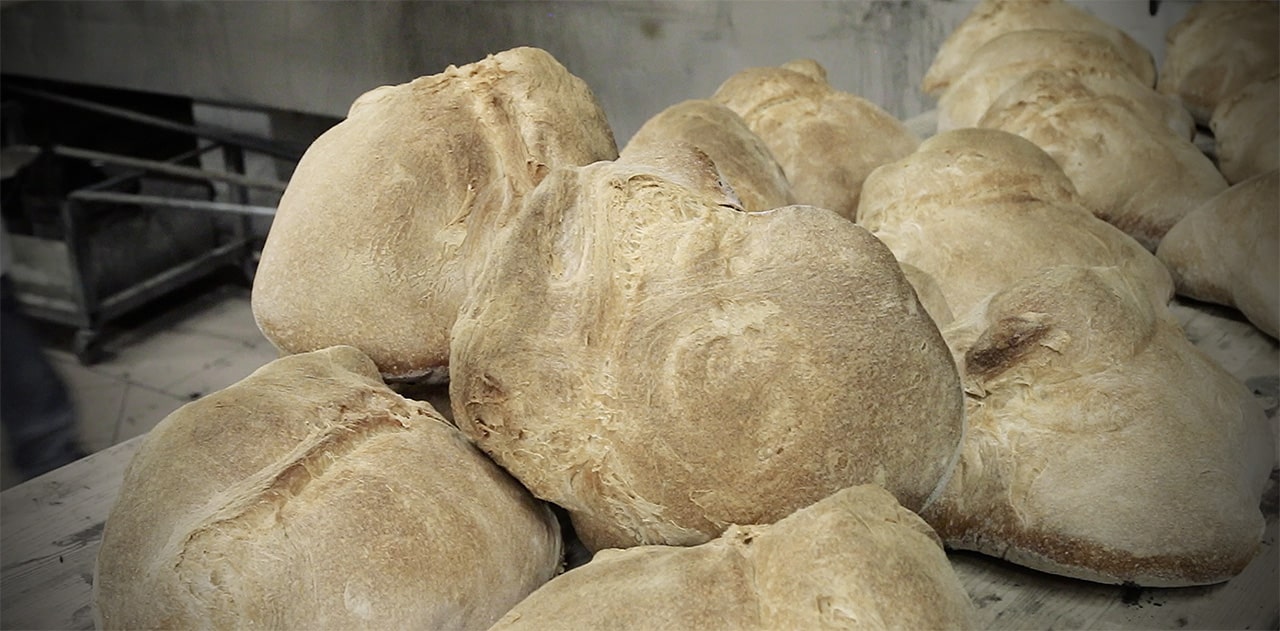This is a very long story about the art of making bread,an art which has been passed on for generations and which has now become an authentic alimentary identity.
Making bread at home was an easy and powerful ritual back in the past, as well as a strong moment to socialize, just as powerful as the mother yeast thanks to which the bread rises. It is a long story that has generated profit for centuries and which, nowadays, is been receiving increasing attention even outside the local dimension. This is the story of Cerchiara bread, a tradition which is bequeathed from mother to daughter, from family to family, and which nowadays, thanks to the rediscovery of this local brand, has become an alimentary identity perfectly able to represent Calabria and Pollino area worldwide. For some time now the new generations, determined not to abandon Southern Italy, have been taking up the baton as well as the responsibility to preserve the culture of bread: a very simple food with a sensational evocative power.
«Bread making is a tradition, and each tradition requires respect and a certain experience- says Vito Elisa- Bread making is an art and art requires love and patience. These are the ingredients that you will most certainly find in our bakery products, because we were taught to do this every day. This is the tradition we want to transmit.» She is one of the women with strong arms who was able to inherit and guard the knowledge of breadmaking from her grandmother and her mother, and now it is her turn to share this ancient wisdom with her daughters, who already help her in her increasingly growing business.
Cerchiara: the town of Bread
In this city, situated on a hill at the foot of MountSellaro in Pollino National Park, there are twelve bakeries, eight historic mills (three of which are still operative), and a Bread museum. Thanks to the bakers of this town, bread goes from being a simple staple food produced to feed their families to a renowned and highly valued business. Here, the bakeries are entirely run by women and are very often located beneath their balconies or near their houses. Among the bakers in Cerchiara, keepers of the art of breadmaking, there are Vito Elisa and her daughters Mariangela and Caterina, contemporary witnesses of a territory that until a few decades ago, as for many other areas of Southern Italy before the abandonment of rural areas, was largely dependent on wheat.
The origin of the town of Cerchiara, located in the middle of a significant monastic area, goes back to the Middle Age, even though the former documents attesting its existence go back to the Byzantine period [X Century] where it is marked with the name of Circlarium.
This town, situated in the North of Calabria and historically held by barons, together with the villages of Plataci and San Lorenzo Bellizzi, was part of Pignatelli’s Duchy starting from 1500. The significant architectural heritage of this town includes: S. Anthony church, the Osservanti monastery [XVII century], S. James church [XV century], the Renaissance-style S. Peter the Apostle church, the ruins of the Medieval Castle built in XIV century, the Sanctuary of S. Maria delleArmi [XV-XVI century] meaningful evidence of Renaissance art; some nineteenth-century nobiliary buildings [Palazzo Rovitti, Palazzo Pistocchi, Palazzo Lupinacci, Palazzo Zuccaro] as well as the Cave of Nymphs, already known to the Sybarites, whose sulphureous waters supply the homonymous Spa.
The art of tradition, everyday
Elisa Vito was already working in a small restaurant business for which she was already baking bread, when in 1983 she and her husband decided to transform her ability in making artisanal traditional bread into a business.
From that moment on, this traditional ritual has been taking place every day. The mother yeast used to make the dough is the same one she inherited from her grandmother, which has been “refreshed” for generations and still shows its power in the production of bakery products that are brought every day to the dining tables of Cerchiara people and to the Italian markets that it has conquered with time.
The unmistakable shape
Folding the dough on itself while it is baking gives its round shape to Cerchiara bread, which features also its typical ‘’hump’’ that resembles the profile of Mount Sellaro overlooking the town.
Cerchiara bread weight ranges from 1 to 5 kg, and the color of the crumb (the softest part of bread) is yellowish, with prominent holes and a very thick crust with an intense aroma.
The list of the ingredients which contribute to making this bread the pride of this community includes:
the flours, which are carefully selected among the local mills, the water from Pollino National Park, the mother yeast, the mild climate of the place, the slow sourdough fermentation, the skilled hands, and the wood-fired oven baking. «Bread is composed by all of this – says Mariangela Nicoletti – It is a whole philosophy contained in a single product. ».
Mariangela Nicoletti | Bakery Marketing Manager Vito Elisa
Elisa Vito | Breadmaking






